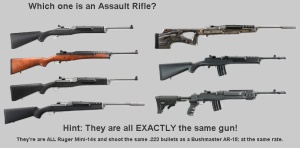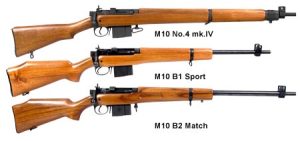The term assault weapon comes up frequently in media reports on guns in society. The term has its origins in the 1980s and is credited to Josh Sugarmann executive director and founder of the Violence Policy Center (VPC) and noted prohibitionist. Before founding the Violence Policy Center in 1988, Sugarmann served as communications director for the National Coalition to Ban Handguns (renamed the Coalition to Stop Gun Violence (CSGV) in 1989). The term assault weapon entered common parlance after Sugarmann authored a publication entitled Assault Weapons and Accessories in America in 1988. Sugarmann and the Violence Policy Center are among those advocates of prohibition who frame the argument that ban is a matter of public health and safety, that this trumps the individual right to own and use guns. In their effort to advance this agenda, prohibitionists resort to the underhanded tactic of framing the debate in a manner that confuses the issue, causing people to quarrel over what is they view as good guns vs bad guns.
The terms assault rifle and assault weapon are all too frequently used interchangeably. What separates an assault rifle from other types of rifles is the modern assault rifle is designed for use in warfare and shares the following characteristics:
It must be an individual weapon with provision to fire from the shoulder (i.e. a buttstock);
It must be capable of selective fire;
It must have an intermediate-power cartridge: more power than a pistol but less than a standard rifle or battle rifle;
Its ammunition must be supplied from a detachable magazine rather than a feed-belt.
And it should at least have a firing range of 300 metres (980 feet) (as cited in Wikipedia)
There was a definition in US law of assault weapon, in the Public Safety and Recreational Firearms Use Protection Act, generally known as the Federal Assault Weapons Ban (AWB), which was in effect from 1994-2004. An assault weapon, as defined by this legislation, was any firearm that carried certain cosmetic features in common with those of assault rifles listed below:
- Semi-automatic rifles able to accept detachable magazines and two or more of the following:
- Folding or telescoping stock
- Pistol grip
- Bayonet mount
- Flash suppressor, or threaded barrel designed to accommodate one
- Grenade launcher mount
- Semi-automatic pistols with detachable magazines and two or more of the following:
- Magazine that attaches outside the pistol grip
- Threaded barrel to attach barrel extender, flash suppressor, handgrip, or suppressor
- Barrel shroud safety feature that prevents burns to the operator
- Unloaded weight of 50 oz (1.4 kg) or more
- A semi-automatic version of a fully automatic firearm.
- Semi-automatic shotguns with two or more of the following:
- Folding or telescoping stock
- Pistol grip
- Fixed capacity of more than 5 rounds
- Detachable magazine. (as cited in Wikipedia)
So essentially, an assault weapon is nothing more than a repeating rifle or shotgun with a semi-automatic action and two or more cosmetic features that make it resemble an assault rifle. It only fanned the flames of the controversy over good guns vs bad guns. The fact remains, however, that these features do not affect how the rifle or shotgun operates; it is still one shot per pull of the trigger. This definition caught on, unfortunately, and the hue and cry for bans on assault weapons persist.
In Canada, the notion of good guns vs bad guns is the thinking behind a critical component of firearms laws. In 1991, John Dixon, an advisor to Kim Campbell, the Minister of Justice in the Federal Government of Prime Minister Brian Mulroney, coined the phrase “all guns out of the wrong hands, and the wrong guns out of all hands.” (as cited in Page, Christopher. The roles of public opinion research in Canadian Government (2006): 133) Kim Campbell, in her capacity as Minister of Justice, enacted Bill C-17 which brought about the following changes to firearms law in Canada: “increased penalties for firearm-related crimes; new Criminal Code offences; new definitions for prohibited and restricted weapons; new regulations for firearms dealers; clearly defined regulations for the safe storage, handling and transportation of firearms; and a requirement that firearm regulations be drafted for review by Parliamentary committee before being made by Governor-in-Council.” (RCMP)
The most contentious aspect of Bill C-17 is the enabling legislation that allows for the introduction of new firearm regulations, including the reclassification of firearms, through Order in Council (OIC). The requirement that new and revised rules be put up for review by a parliamentary committee is included “in order to make the regulation-making process as transparent as possible and to ensure that the interests and expertise of firearms owners are duly taken into account when regulations are both made and amended.” (Library of Parliament) In effect, this legislation allows for the classification or reclassification of any firearm to the three classes of firearm currently used in Canadian law, which consists of non-restricted, restricted and prohibited. The classification and reclassification of firearms are carried out by the RCMP, who draft new regulations concerning the Firearms Reference Table (FRT).
The recent release of revised regulations concerning the Firearms Reference Table (FRT), led to the Swiss Arms Classic Green rifle reclassified from non-restricted to prohibited, despite it being lawful for Canadians to own and use since 2001. The reason given by the RCMP for the reclassification of the Swiss Arms Classic Green rifle from non-restricted to prohibited is that it is a variant of the SG 550 assault rifle manufactured by Swiss Arms. While the Swiss Arms Classic Green rifle is based on the design of the SG 550 assault rifle, it is an entirely separate design manufactured as a sporting arm. It is strictly a repeating rifle with a semi-automatic action. It is also finely crafted and commands a very high price. The RCMP alleges that some of the Swiss Arms Classic Green rifles imported into Canada were refurbished from fully automatic variants such as the prohibited SG 550 assault rifle and could be converted from semi-automatic to full auto. On that basis, the Swiss Arms Classic Green rifle, despite there never been an instance where one was misused in Canada, was reclassified from non-restricted to prohibited with the stroke of a pen.
Despite the requirement that new and revised regulations be put for review by a parliamentary committee, the release of these revised regulations seemingly took the Harper government by surprise. However, the firearms regulation-making process is supposed to be as transparent as possible and to ensure that the interests and expertise of firearms owners are duly taken into account when regulations are both made and amended. The Minister of Public Safety, Steven Blaney, responded quickly, promising owners of these newly prohibited rifles, “I will bring forward an amnesty to ensure that individuals in possession of these firearms can continue to possess their property without threat of criminal charges. The Conservative Government will continue to make our country one of the safest in the world without penalizing law-abiding citizens.” (as cited in the National Post)
It is welcome news form the Minister of Public Safety, but regrettably, the damage is done. Many people formed their opinion based on the menacing looks of the Swiss Arms Classic Green rifle and confusion over fully automatic machine guns versus semi-automatic sporting guns. It gives rise to the belief that which looks like a machine gun is assumed to be a machine gun. The idea that the Swiss Arms Classic Green rifle is a bad gun, that is an assault weapon, and must be prohibited is planted in the minds of the non-gun owning public by this arbitrary reclassification by the RCMP. The classification system for firearms (non restricted, restricted and prohibited) needs to be taken from the RCMP. It must be returned to the purview of parliament, where the addition of new or revised regulations will be subject to a full public review.
- Posted by Geoffrey



Pingback: A Semi-Automatic Firearm Is Not a Machine Gun, And Assault Weapon Is a Made Up Term
Pingback: A Semi-Automatic Firearm Is Not A Machine Gun, And Assault Rifle Is A Made Up Term
Pingback: Assault Rifles: More Deadly Than Other Firearms? – The Graveyard Shift
Pingback: What is an “Assault Weapon” | BlazingCatFur
I like the helpful information you provide in your articles. Ill bookmark your weblog and check again here regularly. I’m quite certain I will learn plenty of new stuff right here! Good luck for the next! ebedafkekbeg